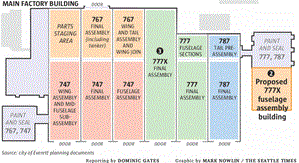Leeham News and Analysis
There's more to real news than a news release.
Retrospective-3, 10/20/09: Dueling Messages: Boeing vs IAM
Read more
Retrospective-2, 10/29/09: 787 Line 2 aftermath
Retrospective-1, 10/28/09: Boeing to Charleston for 787 FAL #2

 Last month, Gov. Jay Inslee of Washington asked Boeing if there was anything the state could do to persuade Boeing do keep Line 1 in Everett.
Last month, Gov. Jay Inslee of Washington asked Boeing if there was anything the state could do to persuade Boeing do keep Line 1 in Everett.With 787 FAL closing and 747 production ending, what does Boeing do with massive space in Everett?
Subscription Required
By Scott Hamilton and Bryan Corliss
Introduction
Oct. 1, 2020, © Leeham News: Boeing is expected to announce as early as today that it will consolidate the 787 final assembly lines into one at its Charleston (SC) plant.

Footprint of Boeing Everett final assembly building. This map is somewhat outdated but a current one is not available. Source: Seattle Times.
Reuters reported last week the decision to consolidate production in Charleston was made. The Wall Street Journal Tuesday night also reported this decision, saying the decision could be announced this week.
The Everett (WA) line is expected to close as production of the 787 falls below seven a month. Boeing previously announced the rate will fall from a peak of 14/mo to 6/mo by 2022.
With the closure of the 747 line in Everett slated for 2022, this will open huge bays in Everett. Nearly half the world’s largest building by volume will be empty. Given lower production rates because of the COVID-19 pandemic, the 777 lines will be woefully underutilized.
Overhead costs probably can’t be absorbed by the remaining low-rate production 767/KC-46A and 777 lines. Boeing warned in its 2Q2020 10Q SEC filing that the 787 and 777 lines face a forward loss depending on production rates of other lines.
With no New Midmarket Airplane (NMA) being contemplated to fill the empty bays, what can Boeing do to utilize these massive spaces and retain profitability of Everett?
A radical solution is moving the 737 line from Renton to Everett. This means Renton would close well before the 2033 date LNA predicts and selling off the property for commercial development.
Related stories
Pontifications: Boeing SC makes its case for 787 production consolidation—and it favors Everett
Sept. 14, 2020, © Leeham News: Boeing’s South Carolina 787 final assembly plant has made its case whether to consolidate production in one location, or not.
The conclusion favors retaining dual assembly lines, retaining one in Everett.
This click-bait lead doesn’t mean Boeing SC management favors retaining dual assembly lines. Far from it.
Pontifications: WA State frets about Boeing brain drain, but it’s already happening
Aug. 31, 2020, © Leeham News: Elected officials and others in Washington State worry about the “brain drain” as Boeing considers whether to consolidate 787 production from Everett to Charleston.
These people are asleep at the switch and have been for some time. The brain drain is already just around the corner.
Nearly half of the membership of SPEEA, the engineers and technicians union at Boeing, are 50 years or older right now.
Almost two thirds of these are within 55-64 years old. In other words, ready for retirement right now or soon to be.
Boeing announces voluntary layoffs in Puget Sound
By Bryan Corliss
April 28, 2020, © Leeham News: Boeing on Monday formally announced it would offer voluntary layoffs – essentially contract buyouts – to members of its Puget Sound workforce.
For most workers, the offer would give them one week’s pay for each year of service, up to a maximum of 26 weeks. Boeing would also continue paying health insurance benefits for most of the laid-off workers for three months. (The exception to this: Machinists Union members will get six months of extended health benefits under the terms of an agreement negotiated in 2016.)
Calhoun faces first test on labor issues
By Bryan Corliss
Jan. 29, 2020 © Leeham News — Two weeks into the job, and new Boeing CEO Dave Calhoun is already facing his first labor-management showdown, with SPEEA, the union for engineers and technical workers at the company’s Puget Sound plants.
On Monday, the vice president of engineering functions for Boeing Commercial Airplanes sent a message to members of SPEEA at Boeing, saying that his team has agreed to meetings with SPEEA’s leadership to discuss “areas of contention between the company and the union.”
Chief among those is SPEEA’s charge that Boeing has been manipulating data used to help calculate annual pay adjustments for engineers and techs, while also allowing front-line managers to blow off annual performance reviews required for engineers and technical workers to determine who would be released first in the event of a layoff.
The union, through a spokesman, declined on Monday to talk about the accusations it’s made in writing about the wage issues. BCA’s VP of engineering functions, Todd Zarfos, said in his note that the two sides have “agreed to refrain from any further accusations and rebuttals about the identified areas of dispute.”
Instead, Zarfos said, they will “work together on possible solutions.”
Summary
- Blistering broadside on pay for engineers, techs.
- SPEEA goes to Legislature to seek end to “Boeing exemption.”
- IAM bargaining unit urges members to save for strike.
- Will Calhoun change management’s approach to labor?
Read more
Collins contract vote keeps 737 landing gear on track
 By Bryan Corliss
By Bryan Corliss
March 11, 2019 (c) Leeham News: Workers at the Collins Aerospace landing gear plant in Everett, WA, have approved their first union contract with the company.
Both sides can come away feeling OK with how they did at the bargaining table. But the biggest winner in these talks actually was Boeing, which now doesn’t have to worry about a break in the flow of 737 landing gear for the next 40 months.
Boeing strikes new pay deal with Machinists
By Bryan Corliss
March 4, 2019, © Leeham News: Boeing and the Machinists Union have come to terms on a deal that will raise wages for the company’s hourly work force and help the company compete for workers in a tight Puget Sound labor market.
The two sides have agreed on a pact that raises new-hire pay by $4 an hour in all job classifications, and raises pay for experienced workers in 32 specific job classifications by as much as $10 an hour.
In all, as many as 16,000 people are getting raises at Boeing, which is about 55% of the IAM-represented work force.
“Not everybody is getting something here, and that’s hard,” said IAM 751 President Jon Holden in an interview with LNA. “But we were using whatever leverage we could to make some improvement.”
In a statement, Boeing said it is “committed to pay that is competitive within the local marketplace.”



